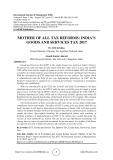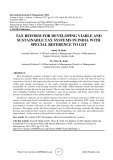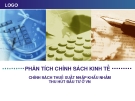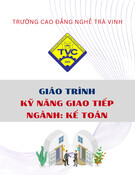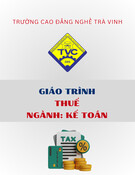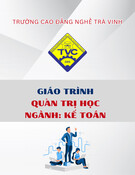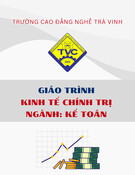
http://www.iaeme.com/IJM/index.asp 53 editor@iaeme.com
International Journal of Management (IJM)
Volume 8, Issue 3, May–June 2017, pp.53–62, Article ID: IJM_08_03_005
Available online at
http://www.iaeme.com/ijm/issues.asp?JType=IJM&VType=8&IType=3
Journal Impact Factor (2016): 8.1920 (Calculated by GISI) www.jifactor.com
ISSN Print: 0976-6502 and ISSN Online: 0976-6510
© IAEME Publication
GST IN INDIA – A SIGNIFICANT TAX
AMENDMENT
Gurveen Kaur
Satyawati College, University of Delhi, Delhi, India
ABSTRACT
The Goods and Services Tax also known as the GST is defined as the giant indirect
tax structures designed to support and enhance the economic growth of a country. The
proposed GST is likely to change the whole scenario of current indirect tax system. It
is considered as biggest tax reform since 1947. More than 150 countries have
implemented GST so far. Currently, in India complicated indirect tax system is
followed with imbrications of taxes imposed by union and states separately. GST will
unify all the indirect taxes under an umbrella and will create a smooth national
market. The idea of GST in India was mooted by Vajpayee government in 2000 and
the constitutional amendment for the same was passed by the Lok sabha on 6th May
2015. Experts say that GST will help the economy to grow in more efficient manner by
improving the tax collection as it will disrupt all the tax barriers between states and
integrate country via single tax rate. However, there is a huge hue and cry against its
implementation. It would be interesting to understand why this proposed GST regime
may hamper the growth and development of the country. GST is one of the most
crucial tax reforms in India which has been long pending. It was supposed to be
implemented from April 2010, but due to political issues and conflicting interests of
various stakeholders it is still pending. However, Goods and Services Tax is likely to
be rolled out on July 1, 2017.
Key words: Direct tax, Indirect tax, GST in India, advantages of GST, disadvantages
of GST.
Cite this Article: Gurveen Kaur, GST in India – A significant Tax Amendment.
International Journal of Management, 8 (3), 2017, pp. 53–62.
http://www.iaeme.com/IJM/issues.asp?JType=IJM&VType=8&IType=3
1. INTRODUCTION
Goods and Services Tax (GST) is an upcoming system of taxation in India which will merge
many individually applied taxes into a single tax. It was introduced as the constitution (one
hundred and first amendment) act 2016, following the passage of Constitution 101st
Amendment Bill. The GST is governed by GST Council and its Chairman is union finance
minister of India, Mr Arun Jaitley.
GST is a comprehensive indirect tax on manufacture, sale and consumption of goods and
services throughout India to replace taxes levied by the central and state governments. This

Gurveen Kaur
http://www.iaeme.com/IJM/index.asp 54 editor@iaeme.com
method allows GST-registered businesses to claim tax credits to the value of GST they paid
on purchase of goods or services as part of their normal commercial activity. Administrative
responsibility would generally rest with a single authority to levy tax on goods and services.
Exports would be considered as zero-rated supply and imports would be levied the same taxes
as domestic goods and services adhering to the destination principle in addition to the
Customs Duty which will not be subsumed in the GST.
Introduction of Goods and Services Tax (GST) is a significant step in the reform of
indirect taxation in India. Amalgamating several Central and State taxes into a single tax
would mitigate cascading or double taxation, facilitating a common national market. The
simplicity of the tax should lead to easier administration and enforcement. From the consumer
point of view, the biggest advantage would be in terms of a reduction in the overall tax burden
on goods, which is currently estimated at 25%-30%, free movement of goods from one state
to another without stopping at state borders for hours for payment of state tax or entry tax and
reduction in paperwork to a large extent.
GST was first introduced by France in 1954 and now it is followed by 140 countries. Most
of the countries followed unified GST while some countries like Brazil, Canada follow a dual
GST system where tax is imposed by central and state both. In India also dual system of GST
is proposed including CGST and SGST. Under this system, the consumer pays the final tax
but an efficient input tax credit system ensures that there is no cascading of taxes- tax on tax
paid on inputs that go into manufacture of goods.
In order to avoid the payment of multiple taxes such as excise duty and service tax at
Central level and VAT at the State level, GST would unify these taxes and create a uniform
market throughout the country. Integration of various taxes into a GST system will bring
about an effective cross-utilization of credits. The current system taxes production, whereas
the GST will aim to tax consumption. On bringing GST into practice, there would be
amalgamation of Central and State taxes into a single tax payment. It would also enhance the
position of India in both, domestic as well as international market.
The Indian GST is expected to represent a leap forward in creating a much cleaner dual
VAT which would minimize the disadvantages of completely independent and completely
centralized systems. A common base and common rates (across goods and services) and very
similar rates (across States and between Centre and States) will facilitate administration and
improve compliance while also rendering manageable the collection of taxes on inter-state
sales. At the same time, the exceptions—in the form of permissible additional excise taxes on
sin goods (petroleum and tobacco for the Centre, petroleum and alcohol for the States)—will
provide the requisite fiscal autonomy to the States. Indeed, even if they are brought within the
scope of the GST, the states will retain autonomy in being able to levy top-up taxes on these
“sin/demerit” goods.
2. LITERATURE REVIEW
Nitin Kumar (2014) studied, “Goods and Service Tax- A Way Forward” and concluded that
implementation of GST in India will help in removing economic distortion by current indirect
tax system and expected to encourage unbiased tax structure which is indifferent to
geographical locations.
Dr. R. Vasanthagopal (2011)2studied,“GST in India: A Big Leap in the Indirect Taxation
System” and concluded that switching to seamless GST from current complicated indirect tax
system in India will be a positive step in booming Indian economy. Success of GST will lead
to its acceptance by more than 130 countries in world and a new preferred form of indirect tax
system in Asia also.

GST in India – A significant Tax Amendment
http://www.iaeme.com/IJM/index.asp 55 editor@iaeme.com
Agogo Mawuli (May 2014)1 studied, “Goods and Service Tax-An Appraisal” and found
that GST is not good for low-income countries and does not provide broad based growth to
poor countries. If still these countries want to implement GST then the rate of GST should be
less than 10% for growth.
Pinki, Supriya Kamma and Richa Verma (July 2014)7 studied, “Goods and Service Tax-
Panacea For Indirect Tax System in India” and concluded that the new NDA government in
India is positive towards implementation of GST and it is beneficial for central government,
state government and as well as for consumers in long run if its implementation is backed by
strong IT infrastructure.
3. OBJECTIVES
• To contemplate the concept of Goods and Services Tax
• To study the features of Goods and Services Tax
• To evaluate the advantages and challenges of Goods and Services Tax
• To suggest further research direction on Goods and Services Tax
4. METHODOLOGY
The research design to gain insights into GST is chosen to be exploratory. Research papers
that appeared on the theme of GST were collected from different data sources like WILEY,
JSTOR, Emerald, SAGE etc. from 2011 onwards to 2014 and were analysed to explore the
various dimensions relating to the concept of GST. The accessible secondary data is also
intensively used for research study which included data from several journals, articles,
newspapers and magazines.
5. CONCEPT OF GST
GST is an indirect tax which will subsume almost all the indirect taxes of central government
and states governments into a unified tax. As the name suggests it will be levied on both
goods and services at all the stages of value addition. It has dual model including central
goods and service tax (CGST) and states goods and service tax (SGST). CGST will subsume
central indirect taxes like central excise duty, central sales tax, service tax, special additional
duty on customs, counter veiling duties whereas indirect taxes of state governments like state
vat, purchase tax, luxury tax, octroi tax, tax on lottery and gambling will be replaced by
SGST. Integrated goods and service tax (IGST) also called interstate goods and service tax is
also a component of GST. It is not an additional tax but it is a system to examine the interstate
transactions of goods and services and to further assure that the tax should be received by the
importer state as GST is a destination based tax. Under this system, the consumer pays the
final tax but an efficient input tax credit system ensures that there is no cascading of taxes- tax
on tax paid on inputs that go into manufacture of goods.
Introduction of GST would also make Indian products competitive in the domestic and
international markets. Studies show that this would have a boosting impact on economic
growth. Last but not the least, this tax, because of its transparent and self-policing character,
would be easier to administer.
6. FEATURES OF GST
The salient features of GST are as under:
• GST would be applicable on “supply” of goods or services as against the present concept of
tax on the manufacture of goods or on sale of goods or on provision of services.
• GST would be based on the principle of destination based consumption taxation as against the
present principle of origin based taxation.

Gurveen Kaur
http://www.iaeme.com/IJM/index.asp 56 editor@iaeme.com
• It would be a dual GST with the Centre and the States simultaneously levying it on a common
base. The GST to be levied by the Centre would be called Central GST (CGST) and that to be
levied by the States [including Union territories with legislature] would be called State GST
(SGST). Union territories without legislature would levy Union territory GST (UTGST).
• An Integrated GST (IGST) would be levied on inter-State supply (including stock transfers) of
goods or services. This would be collected by the Centre so that the credit chain is not
disrupted.
• Import of goods would be treated as inter-State supplies and would be subject to IGST in
addition to the applicable customs duties.
• Import of services would be treated as inter-State supplies and would be subject to IGST.
• CGST, SGST /UTGST & IGST would be levied at rates to be mutually agreed upon by the
Centre and the States under the aegis of the GSTC.
• GST would replace the following taxes currently levied and collected by the Centre:
o Central Excise Duty;
o Duties of Excise (Medicinal and Toilet Preparations);
o Additional Duties of Excise (Goods of Special Importance);
o Additional Duties of Excise (Textiles and Textile Products);
o Additional Duties of Customs (commonly known as CVD);
o Special Additional Duty of Customs (SAD);
o Service Tax;
o Cesses and surcharges insofar as they relate to supply of goods or services.
• State taxes that would be subsumed within the GST are:
o State VAT;
o Central Sales Tax;
o Purchase Tax;
o Luxury Tax;
o Entry Tax (All forms);
o Entertainment Tax (except those levied by the local bodies);
o Taxes on advertisements;
o Taxes on lotteries, betting and gambling;
o State cesses and surcharges insofar as they relate to supply of goods or services.
• GST would apply to all goods and services except Alcohol for human consumption.
• GST on five specified petroleum products (Crude, Petrol, Diesel, ATF & Natural gas) would
be applicable from a date to be recommended by the GSTC.
• Tobacco and tobacco products would be subject to GST. In addition, the Centre would
continue to levy Central Excise duty.
• A common threshold exemption would apply to both CGST and SGST. Taxpayers with an
annual turnover of Rs. 20 lakh (Rs. 10 lakh for special category States as specified in article
279A of the Constitution) would be exempt from GST. A compounding option (i.e. to pay tax
at a flat rate without credits) would be available to small taxpayers (including to specified
category of manufacturers and service providers) having an annual turnover of up to Rs. 50
lakh. The threshold exemption and compounding scheme would be optional.
• The list of exempted goods and services would be kept to a minimum and it would be
harmonized for the Centre and the States as well as across States as far as possible.
• Exports would be zero-rated.
• Credit of CGST paid on inputs may be used only for paying CGST on the output and the
credit of SGST/UTGST paid on inputs may be used only for paying SGST/UTGST. In other

GST in India – A significant Tax Amendment
http://www.iaeme.com/IJM/index.asp 57 editor@iaeme.com
words, the two streams of input tax credit (ITC) cannot be cross utilized, except in specified
circumstances of inter-State supplies for payment of IGST. The credit would be permitted to
be utilized in the following manner:
o ITC of CGST allowed for payment of CGST & IGST in that order;
o ITC of SGST allowed for payment of SGST & IGST in that order;
o ITC of UTGST allowed for payment of UTGST & IGST in that order;
o ITC of IGST allowed for payment of IGST, CGST & SGST/UTGST in that order.
o ITC of CGST cannot be used for payment of SGST/UTGST and vice versa.
• Accounts would be settled periodically between the Centre and the State to ensure that the
credit of SGST used for payment of IGST is transferred by the originating State to the Centre.
Similarly the IGST used for payment of SGST would be transferred by Centre to the
destination State. Further the SGST portion of IGST collected on B2C supplies would also be
transferred by Centre to the destination State. The transfer of funds would be carried out on
the basis of information contained in the returns filed by the taxpayers.
• Input Tax Credit (ITC) to be broad based by making it available in respect of taxes paid on
any supply of goods or services or both used or intended to be used in the course or
furtherance of business.
• Electronic filing of returns by different class of persons at different cutoff dates.
• Various modes of payment of tax available to the taxpayer including internet banking, debit/
credit card and National Electronic Funds Transfer (NEFT) / Real Time Gross Settlement
(RTGS).
• Obligation on certain persons including government departments, local authorities and
government agencies, who are recipients of supply, to deduct tax at the rate of 1% from the
payment made or credited to the supplier where total value of supply, under a contract,
exceeds two lakh and fifty thousand rupees (Rs. 2.5 lac).
• Refund of tax to be sought by taxpayer or by any other person who has borne the incidence of
tax within two years from the relevant date.
• Obligation on electronic commerce operators to collect ‘tax at source’, at such rate not
exceeding two per cent. (2%) of net value of taxable supplies, out of payments to suppliers
supplying goods or services through their portals.
• System of self-assessment of the taxes payable by the registered person.
• Audit of registered persons to be conducted in order to verify compliance with the provisions
of Act.
• Limitation period for raising demand is three (3) years from the due date of filing of annual
return or from the date of erroneous refund for raising demand for short-payment or non-
payment of tax or erroneous refund and its adjudication in normal cases.
• Limitation period for raising demand is five (5) years from the due date of filing of annual
return or from the date of erroneous refund for raising demand for short-payment or non-
payment of tax or erroneous refund and its adjudication in case of fraud, suppression or wilful
misstatement.
• Arrears of tax to be recovered using various modes including detaining and sale of goods,
movable and immovable property of defaulting taxable person.
• Officers would have restrictive powers of inspection, search, seizure and arrest.
• Goods and Services Tax Appellate Tribunal would be constituted by the Central Government
for hearing appeals against the orders passed by the Appellate Authority or the Revisional
Authority. States would adopt the provisions relating to Tribunal in respective SGST Act.
• Provision for penalties for contravention of the provision of the proposed legislation has been
made.

![Câu hỏi ôn tập Phân tích chính sách thuế [chuẩn nhất]](https://cdn.tailieu.vn/images/document/thumbnail/2025/20250630/nhinhi_2512/135x160/9611751338066.jpg)




